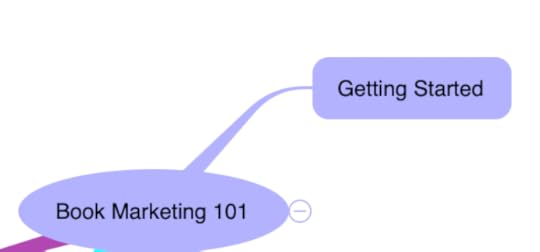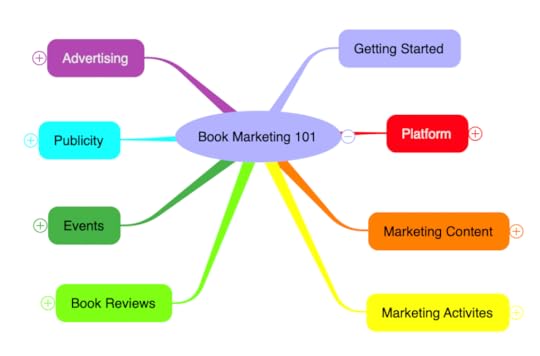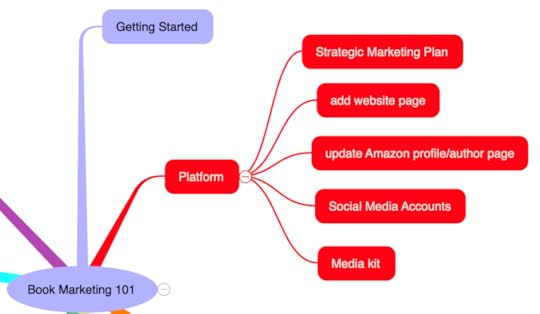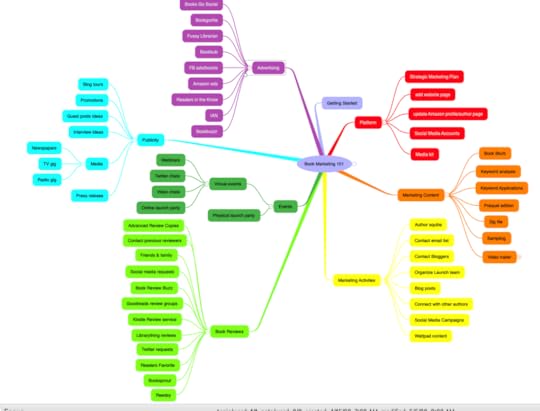Mind-mapping a Table of Contents
by Hank Quense, @hanque99
It may seem odd, but when starting a new non-fiction book project my initial step is to open a mind-mapping program and begin working on the Table of Contents. I like information presented graphically rather than in lists or tables which I find rather boring so I use mind-maps as an alternative to these lists and tables.
The process of creating the mind-map frequently triggers new ideas and thoughts that tend to enrich the book project I’m starting.
To illustrate this concept, I’ll use my recent book called Book Marketing Fundamentals. I’ve self-published a number of books and been involved in their marketing so I have a lot of experience in this area. In the beginning, the “book” consisted of a jumble of ideas and potential topics. Obviously, I had to sort this mess out before I could start on writing the book. That’s where the mind-mapping comes in. I use it for a few purposes. The first is to bring a bit of order to the mess and the second to organize the book.
For the record, I used iThoughtsX as the mind-mapping program but any of the many mind-mapping programs available will do.
This graphic depicts my initial step and shows what will be the initial chapter. Notice the interim book title. While this isn’t exactly a giant step, it is a start. After more head-scratching, revising and changing my mind, I ended up with this diagram showing the chapters in the book.
Besides being colorful, it represents the another step in organizing the book project. (it’s also a great marketing image!). Now the job shifts to determining the topics in each chapter.
This step is essentially where the book takes shape, topic by topic. The activity involves a lot of thinking about whether a topic belongs in this chapter or a different one. One big advantage of the mind-maps is the ease to move topic from one chapter to another. The graphic shows the topics assigned to the chapter devoted to talking about the marketing platform.
As you might expect by now, the complete TOC mind-map is quite large. I reduced the size of it in order to be able to show the entire graphic.
This then is the roadmap to write the book. The next step is to open a new Scrivener file and outline the book in accordance with the mind-map.
A possible reaction to this last graphic is, “Very nice. Very pretty, but why bother? Why not just write the bloody book and skip the time wasted on mind-mapping?”
This is a valid question and, in my opinion (and experience), just writing the book results in a lot of wasted time when completed topics are judged to be irrelevant to the book’s theme or objective and have to be deleted. Further, just writing the book ends up with topics getting moved from one chapter to another. This is a minor issue with Scrivener as the topics can be dragged to a different location. If the book is written using a standard word processor. the rearranging can be a major problem.
Getting the topics correctly laid out in the beginning will save a lot of time at the end. And mind-mapping the Table of Contents is a great way to accomplish that.
~ ~ ~

My Writers and Authors Resource Center has content that is helpful to fiction writes, self-publishing authors and authors looking for marketing help
Brainstorm a Nonfiction Book With Mind-Mapping (by @hanque99 ):
Click To Tweet
The post Mind-mapping a Table of Contents appeared first on Elizabeth Spann Craig.








